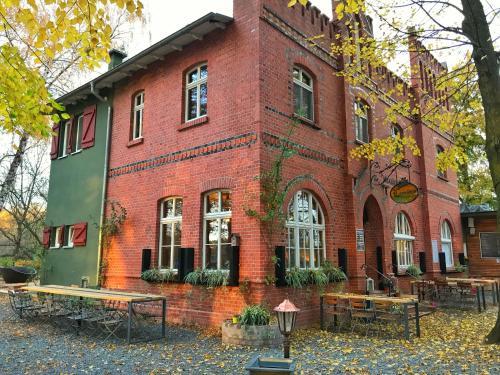Bauhaus and its Sites in Weimar and Dessau, Germany
I often find it a bit hard to understand how revolutionary something was in its time – especially when today it just seems normal.
There have been a few times now when I’ve noticed this in the world of architecture. Germany’s Bauhaus movement is the latest.
The sleek minimalistic look of the Bauhaus style, with a modernist feel and a harmony between aesthetics and practicality, developed between 1919 and 1933.
At the time, it was viewed with suspicion but Bauhaus set the scene for a new wave of architecture and design that was to sweep across the world.
The movement itself was all about teaching, learning and collaboration. It started in the city of Weimar where a new guild of artists, designers and architects came together under the Bauhaus name to work without class on the new principles.
They had a dream for a new wave of style and together they developed it in their own ways and as a group.
Two buildings here represent the beginning of the movement – the former Art College and the School of Arts and Crafts – both of which are still used as a university today.
Also, a little further out from the city centre is the Haus am Horn. This small cubic residence is an example of the early Bauhaus architecture and, although it has had some renovation work, is the only original Bauhaus building in the city.
The Bauhaus movement was the subject of political pressures in Weimar. Conservatives in power in the region were wary of the progressive nature of the design movement and made funding for the school difficult in the mid-1920s.
In 1925, the Weimar Bauhaus was forced to close and the design collective relocated to the city of Dessau where there was more support for the movement.
It was in Dessau that things really took off. World-class artists joined the teaching staff and the influence of the architecture spread further afield.
Larger buildings were constructed with the assistance of local authorities and some of the truly groundbreaking elements of the style were developed and put into practice.
The most famous of the movement’s buildings – known just as the Bauhaus building – is the modern architectural highlight of Dessau and is still used to promote the ideals of the design revolution.
Just a short walk away from here is a series of homes known as the Masters’ Houses. The five houses are set is lush gardens and were the residences of the senior teachers of the school and, as you would expect, exemplify the architectural vision of Bauhaus.
Visiting the Bauhaus Sites in Weimar and Dessau
To see all of the Bauhaus buildings included in the World Heritage Site, you’ll need to visit two German cities – Weimar and Dessau, which are about 150 kilometres apart.
Both Weimar and Dessau each have another World Heritage Site, so make sure you also see the Classical Weimar and the Garden Kingdom of Dessau-Worlitz.
In Weimar, the former Art College and the School of Arts and Crafts are now part of a university and you are able just to walk in and have a look at the buildings for yourself. There are also city tours available which include these sites.
The Haus am Horn is about 20 minutes walk from the university buildings and is a small residence in the Bauhaus style. It is only open on Wednesday, Saturday and Sunday between April and September.
The Bauhuas University buildings in Weimar are located at Geschwister-Scholl-Straße 8, Bauhaus-University Weimar, 99423, Weimar, Germany.
The Haus am Horn in Weimar is located at Am Horn 61, 99425 Weimar, Germany.
You can see it on a map here.
To get to the Bauhaus sites in Weimar, catch the train to Weimar and then take one of the many buses which leave from the station towards the town centre.
THE BEST ACCOMMODATION IN WEIMAR
Here are some accommodation recommendations if you are going to stay in Weimar to explore the Bauhaus sites.
BACKPACKER
For a good backpacker option, I would suggest the funky Labyrinth Hostel on the main square.
BUDGET
For a simple and affordable, your best option is probably Comfort Hotel.
BOUTIQUE
There are some lovely design hotels in Weimar and I would recommend Pension Mariposa.
LUXURY
And for some special luxury, have a look at Hotel Elephant on the town square.
If you can only visit one of the cities, then Dessau is probably the better option.
The main Bauhaus building is a true representation of what the movement stands for and also has a shop and museum with some of the design examples that were developed at the same time.
The nearby Masters’ Houses show more of a progression in the Bauhaus principles than the residence in Weimar and are also easier to access because they are all open to the public most of the year.
The Bauhuas Building in Dessau is located at Gropiusallee 38, 06846, Dessau, Germany.
The Masters’ Houses in Dessau are located at Ebertallee 67, 06846 Dessau-Roßlau, Germany.
The Bauhaus Building is open every day from 1000 – 1700.
The Masters’ Houses are open at the following times:
October – March: 1100 – 1700
April – September: 1000 – 1700
A ticket for a 2 hour visit to either the Bauhaus Building or the Masters’ Houses is €7.50 for adults and €4.50 for concession.
A combined ticket to both the Bauhaus Building and the Masters’ Houses, including a guided tour, is €16 for adults and €11.50 for concession.
To get to the Bauhaus Building in Dessau, catch the train to Dessau and then it’s a short 10 minute walk to the building.
You can find out more information at the official website for the Bauhaus Building and Masters’ House.
THE BEST ACCOMMODATION IN DESSAU
And here are some of my suggestions for places to stay in Dessau, which is worth staying for a night or two to see the Garden Kingdom.
BUDGET
For a nice and comfortable affordable hotel, try Hotel Kuehnauer Hof.
GUESTHOUSE

If you’re interested in a family-run guesthouse with a beer garden (who isn’t?) then have a look at Landhaus Dessau.
BUSINESS

For a really nice modern hotel, DORMERO Hotel Dessau is a great four star place.
LUXURY
For another good four star accommodation in Dessau, have a look at the Radisson Blu Fürst Leopold Hotel.
Time Travel Turtle was supported by DB Bahn, the German National Tourist Board and Youth Hostels in Germany but the opinions, over-written descriptions and bad jokes are his own.
Very cool pictures and interesting post! You’re right that it’s weird to think how something normal today was so revolutionary not so long ago. Thanks for sharing!
What’s Going down i’m new to this, I stumbled upon this I have discovered It positively useful and it has aided me out loads.
I hope to contribute & help other users like its aided me. Great job.
It would be useful to have information on the distance and time on the train from Berlin and other major cities. Your information says “catch the train” but does not say from where or how long it would take. Thank you
Hi Rachel. Thanks for the comment – and I appreciate the point you’re making. However, I intentionally tell people the arrival train station but not the departure one because I have no idea where people are coming from. Yes, they could be coming from Berlin – but they could also be coming from Leipzig, Dresden, Prague, Hannover, and so on. I don’t think it’s realistic to list the distance and time from 10 different cities.
I would always recommend people use the Deutsche Bahn website and type in their departure city to get all of those details. Good luck!!